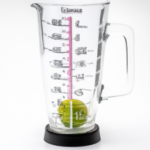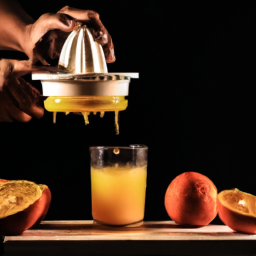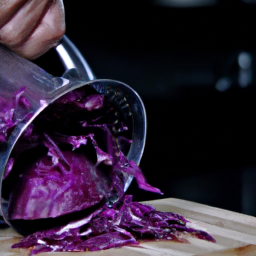As someone who enjoys both cooking and baking, I often come across recipes that call for lime juice. However, determining the precise amount of juice from a single lime can be tricky. This can lead to either too much or too little lime juice, affecting the flavor and texture of the dish.
In this article, I will explore the various factors that affect lime juice yield and provide tips for getting the most out of your limes. Factors that affect lime juice yield include the ripeness of the lime, the method of juicing, and the type of juicer used. Hand squeezing a lime can yield different results compared to using a citrus juicer or a blender. Additionally, the amount of juice can vary depending on whether the lime is fully ripe or not.
By understanding these factors, you can ensure that you get the right amount of juice for your recipe and avoid any mishaps. So, let’s dive in and explore the best ways to get the most juice out of your limes.
Key Takeaways
- One lime typically yields about 2 tablespoons or 1 fluid ounce of juice on average.
- Lime juice substitutes can alter the taste of a dish.
- Measuring accuracy is crucial for lime juice preservation, and using a measuring cup with both tablespoons and ounces marked is helpful.
- Lime juice can affect the flavor and texture of a dish, and factors affecting lime juice yield include ripeness, size, and juiciness.
Factors Affecting Lime Juice Yield
You’ll be happy to know that the amount of lime juice you can get from one lime depends on factors like its ripeness, size, and juiciness!
When it comes to lime juice extraction, you want to choose limes that are ripe, firm, and heavy for their size. Limes that are too ripe or soft may have lower juice content and higher acidity levels, which can affect the flavor of your dish.
In addition to ripeness, lime size also plays a role in determining how much juice you can extract. Larger limes may yield more juice than smaller ones, but this can vary depending on the variety of lime.
Juiciness is another factor to consider, as limes with thin skins and more pulp tend to have higher juice content.
Ultimately, the amount of lime juice you can get from one lime will depend on these factors, as well as your juicing method. Speaking of which, let’s take a look at the hand juicing method!
Hand Juicing Method
When using the hand juicing method, all you need is a firm grip and a little elbow grease to extract every last drop of tangy goodness from that citrus fruit. Here are some benefits of hand juicing and techniques to make the process easier:
-
Use room temperature limes: Limes that are at room temperature will be easier to juice than those that are cold.
-
Cut the lime in half: Use a sharp knife to cut the lime in half, lengthwise.
-
Squeeze the lime: Place the lime half in the palm of your hand and squeeze it as hard as you can. Use your other hand to catch the juice.
-
Rotate the lime: If you’re having trouble getting all the juice out, rotate the lime half and squeeze it again.
Hand juicing is a great way to extract lime juice for your recipes, and it has several benefits. Not only is it inexpensive and easy, but it also allows you to control the amount of juice you extract. However, if you’re looking for a faster and more efficient method, using a citrus juicer might be a better option.
Using a Citrus Juicer
Get ready to experience the ultimate convenience and efficiency of using a citrus juicer for extracting the tangy goodness from your citrus fruits. This method is perfect for those who want to maximize the juice yield from their fruits while minimizing the effort it takes to get it done.
Using a citrus juicer is straightforward and easy to master, making it a popular choice for many households. When using a citrus juicer, there are several juicing techniques that you can employ depending on the type of citrus fruit you are using.
For example, for larger fruits such as oranges and grapefruits, it is best to cut them into quarters before juicing. On the other hand, smaller fruits like limes and lemons can be cut into halves. Simply place the fruit on the juicer and press down on the handle to extract the juice.
In no time, you’ll have a fresh and delicious juice that can be used in a variety of recipes. If you’re looking for an alternative way to extract juice, using a blender or food processor is another option. However, this method requires a little more effort and clean-up time.
Using a Blender or Food Processor
To extract juice using a blender or food processor, all you need to do is chop the fruits into smaller pieces and blend on high speed for about 30 seconds until pureed, which can yield up to 30% more juice than manual squeezing. This method is more efficient and faster compared to hand squeezing.
Here are some tips for using a blender or food processor to extract lime juice:
- Cut the lime into smaller pieces to fit into the blender or food processor.
- Add a little bit of water to help break down the lime and make it easier to blend.
- Strain the puree to remove any seeds or pulp that may have been blended in.
- You can also freeze the puree to use later as a marinade or in cocktails.
- Remember to clean the blender or food processor thoroughly after use to avoid any cross-contamination with other foods.
When it comes to lime juice extraction techniques, using a blender or food processor is a great option for those who want to extract more juice with less effort. However, it’s important to note that the yield of lime juice can vary depending on the freshness and ripeness of the lime.
In the next section, we’ll discuss how to convert lime juice measurements to ensure accurate and consistent use in recipes.
Converting Lime Juice Measurements
I often find myself converting lime juice measurements when cooking or making cocktails. It’s important to know how many tablespoons are in an ounce, as this is a common unit of measurement for lime juice.
Additionally, understanding how much juice one lime typically yields can also be helpful in recipe development.
Tablespoons to Ounces Conversion
Converting tablespoons to ounces is like measuring drops of water in a bucket. It may seem like a small detail, but measuring accuracy is crucial for lime juice preservation.
Here are three helpful tips to convert tablespoons to ounces:
-
Remember that 1 tablespoon is equal to 0.5 ounces. This means that if a recipe calls for 4 tablespoons of lime juice, you’ll need 2 ounces.
-
Use a measuring cup that has both tablespoons and ounces marked on it. This will ensure that you’re measuring accurately and avoid over or underestimating the amount of lime juice needed.
-
If you don’t have a measuring cup with both units marked, use an online converter or a conversion chart to ensure accuracy. This is especially important for baking recipes where precise measurements are key to successful outcomes.
Now that you’ve got a better understanding of how to convert tablespoons to ounces, let’s move on to the next step – determining how much juice is in one lime.
Juice of One Lime Conversion
You’ll be pleasantly surprised at how much zest and flavor one lime can add to your dish once you’ve mastered the art of extracting its precious nectar. But how much lime juice do you actually get from one lime? The answer is: it depends on the size and juiciness of the lime. On average, one lime yields about 2 tablespoons or 1 fluid ounce of juice. However, some limes can yield as little as 1 tablespoon or as much as 4 tablespoons of juice. It’s always a good idea to have an extra lime or two on hand, just in case your lime is on the drier side. If you’ve ever asked yourself, “how much juice in one lime?”, remember that it’s not an exact science, but knowing the average can help you plan your recipes. To ensure you get the most juice, try rolling the lime on your countertop before cutting, as this helps release more liquid from its cells. You can also microwave the lime for about 10-15 seconds to soften it up, making it easier to extract even more juice. So, when you’re wondering *how many limes for one ounce*, remember that it typically takes one average lime, but it’s always wise to account for variations in juiciness. With these techniques, you’ll get the most out of every lime, ensuring your dishes are packed with citrusy goodness.
To give you a better idea of how much lime juice you can expect from a lime, here’s a table that compares the juice yield of different sizes of limes:
| Lime Size | Juice Yield |
|---|---|
| Small | 1 – 2 tbsp |
| Medium | 2 – 3 tbsp |
| Large | 3 – 4 tbsp |
Aside from being a versatile ingredient in cooking, lime juice also offers several health benefits. It’s a good source of vitamin C, which helps boost the immune system and promotes healthy skin. Lime juice also contains antioxidants that can protect against cell damage and reduce inflammation. If you don’t have fresh lime on hand, you can use lime juice substitutes like lemon juice or vinegar. However, keep in mind that they may alter the taste of your dish.
To get the most juice from limes, there are a few tips you can follow. Stay tuned for the next section where I’ll share some tricks for squeezing every last drop of juice from your limes.
Tips for Getting the Most Juice from Limes
Getting the most juice out of limes can be tricky, but with a few simple techniques, you can maximize the yield. One way to get more juice from a lime is to roll it on a hard surface before cutting it. This helps to break down the fibers inside the lime, making it easier to extract more juice.
Another helpful tip is to microwave the lime for 10-15 seconds before juicing it. This can help to soften the lime and make it easier to extract the juice.
In addition to using these juicing techniques, it’s also important to consider other uses for limes. For example, lime zest can add a bright, citrusy flavor to dishes like salads, marinades, and desserts. To zest a lime, use a microplane or zester to remove the outer layer of the skin. This can be used immediately or frozen for later use.
With these tips in mind, you can get the most out of your limes and reduce waste. Speaking of waste, let’s talk about how to store leftover lime juice.
Storing Leftover Lime Juice
Hey, don’t let that leftover lime juice go to waste! Here’s how to keep it fresh and ready for your next cocktail or recipe.
First off, make sure to transfer the lime juice into an airtight container. This will prevent the juice from oxidizing and keep it fresh for longer. Additionally, you can try freezing the lime juice using ice cube trays. Once frozen, you can store the lime juice cubes in a freezer-safe bag or container. This is a great option if you don’t plan on using the juice anytime soon but want to keep it fresh for future use.
If you find yourself with too much leftover lime juice, there are plenty of alternative uses besides drinks and recipes. For example, you can use lime juice to clean and deodorize your kitchen or bathroom. Lime juice is a natural disinfectant and can help remove stubborn stains and odors. You can also use lime juice as a marinade for meats or vegetables, or mix it with olive oil for a flavorful salad dressing.
Now that you know how to store and use leftover lime juice, let’s move on to some delicious recipes that feature this zesty ingredient.
Recipes That Use Lime Juice
Let’s explore some tasty recipes that incorporate the tangy flavor of lime juice! Lime juice is a versatile ingredient that can be used in a variety of dishes, from savory to sweet.
One popular use of lime juice is in cocktails, such as margaritas and mojitos. The acidity of the lime juice balances out the sweetness of the other ingredients, creating a refreshing and delicious drink.
But lime juice isn’t just for cocktails. It also has many benefits in cooking. The acidity of the lime juice can help tenderize meat and seafood, making it a great marinade ingredient. Lime juice can also add a bright and fresh flavor to salads, salsas, and sauces.
So next time you’re looking to add some zing to your cooking, consider reaching for a lime and adding some fresh juice to your dish.
Frequently Asked Questions
Can I use bottled lime juice instead of fresh lime juice?
Using bottled lime juice is a convenient option, but fresh lime juice offers more benefits. It contains more nutrients and has a brighter flavor. To store bottled lime juice, keep it refrigerated and use it within 7-10 days for best results.
How long does it take to juice one lime by hand?
When juicing by hand, it takes me about 1-2 minutes to juice one lime. Efficiency tips include rolling the lime on a hard surface before cutting and using a reamer. Electric juicing is faster, but may not yield as much juice.
Can I freeze leftover lime juice?
Yes, leftover lime juice can be frozen in ice cube trays and then stored in a freezer-safe container. It’s perfect for adding a burst of citrus to drinks or recipes. Just thaw what you need and use it as desired.
How do I know if a lime is ripe enough to juice?
To evaluate ripeness, I squeeze the lime gently. If it’s soft and yields to pressure, it’s ready for juicing. Cut the lime in half, place it flesh side down, and press or twist to extract the juice.
Is it okay to use lime juice from a lime that has been cut and stored in the fridge for a few days?
As long as the cut lime has been stored properly in the fridge, using its juice is perfectly fine. When it comes to how much juice to use, it depends on the recipe. Leftover lime juice can be used in marinades, dressings, or even as a refreshing addition to water. Remember, waste not, want not.
Conclusion
So, there you have it – the amount of lime juice you can expect to get from one lime can vary based on several factors. But fear not, by following the tips and techniques outlined in this article, you can maximize your yield and ensure you have enough juice for all your culinary needs.
Now, some of you may be thinking that squeezing limes by hand or using a juicer seems like a lot of effort for just a small amount of juice. But let me tell you, the flavor and freshness of freshly squeezed lime juice can’t be beat.
Plus, using fresh juice in your cooking and cocktails is a great way to add a burst of flavor and health benefits. So next time you reach for that bottle of pre-squeezed lime juice, consider giving the real thing a try – your taste buds will thank you.
Susannah expertise lies in researching and compiling evidence-based content on juicing, nutrition, and overall health. She is committed to ensuring that The Juicery World offers accurate, up-to-date, and trustworthy information to empower readers to take control of their health. Susannah’s goal is to inspire individuals to embrace juicing as a way to nourish their bodies and live their best lives.

















